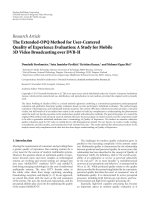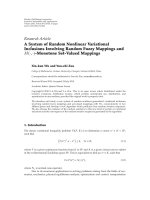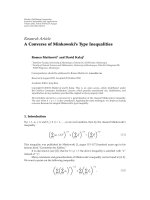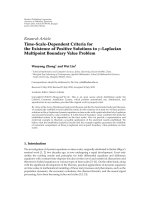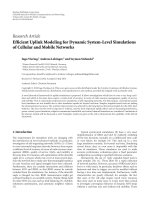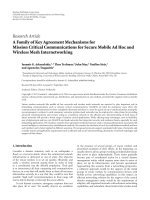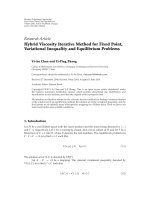Báo cáo hóa học: " Research Article A General Projection Method for a System of Relaxed Cocoercive Variational Inequalities in Hilbert Spaces" pot
Bạn đang xem bản rút gọn của tài liệu. Xem và tải ngay bản đầy đủ của tài liệu tại đây (505.11 KB, 9 trang )
Hindawi Publishing Corporation
Journal of Inequalities and Applications
Volume 2007, Article ID 45398, 9 pages
doi:10.1155/2007/45398
Research Article
A General Projection Method for a System of Relaxed Cocoercive
Variational Inequalities in Hilbert Spaces
Meijuan Shang, Yongfu Su, and Xiaolong Qin
Received 2 June 2007; Accepted 19 July 2007
Recommended by Saburou Saitoh
We consider a new algorithm for a generalized system for relaxed cocoercive nonlinear
inequalities involving three different operators in Hilbert spaces by the convergence of
projection methods. Our results include the previous results as special cases extend and
improve the main results of R. U. Verma (2004), S. S. Chang et al. (2007), Z. Y. Huang
and M. A. Noor (2007), and many others.
Copyright © 2007 Meijuan Shang et al. This is an open access article distributed under
the Creative Commons Attribution License, which permits unrestricted use, distribution,
and reproduction in any medium, provided the original work is properly cited.
1. Introduction and preliminaries
Variational inequalities introduced by Stampacchia [1] in the early sixties have had a great
impact and influence in the development of almost all branches of pure and applied sci-
ences and have witnessed an explosive g rowth in theoretical advances and algorithmic
development; see [1–11] and references therein. It is well known that the variational in-
equality problems are equivalent to the fixed point problems. This alternative equivalent
formulation is very important from the numerical analysis point of view and has played
a significant part in several numerical methods for solving variational inequalities and
complementarity; see [2, 4]. In particular, the solution of the v ariational inequalities can
be computed using the iterative projection methods. It is well known that the convergence
of the projection method requires the operator T to be strongly monotone and Lipschitz
continuous. Gabay [5] has shown that the convergence of a projection method can be
proved for cocoercive operators. Note that cocoercivity is a weaker condition than strong
monotonicity. Recently, Verma [8] introduced a system of nonlinear strongly monotone
variational inequalities and studied the approximation solvability of this system based on
a system of projection methods. Chang et al. [3] also introduced a new system of nonlin-
ear relaxed cocoercive variational inequalities and studied the approximation solvability
2 Journal of Inequalities and Applications
of this system based on a system of projection methods. Projection methods have been
applied widely to problems arising especially from complementarity, convex quadratic
programming, and variational problems.
In this paper, we consider, based on the projection method, the approximation solv-
ability of a system of nonlinear relaxed cocoercive variational inequalities with three
different relaxed cocoercive mappings and three quasi-nonexpansive mappings in the
framework of Hilbert spaces. Solutions of the system of nonlinear relaxed cocoercive vari-
ational inequalities are also common fixed points of three different quasi-nonexpansive
mappings. Our results obtained in this paper generalize the results of Chang et al. [3],
Verm a [8–10], Huang and Aslam Noor [6], and some others.
Let H be a real Hilbert space whose inner product and norm are denoted by
·,· and
·, respectively. Let C be a closed convex subset of H and let T : C → H be a nonlinear
mapping. Let P
C
betheprojectionofH onto the convex subset C. The classical variational
inequality denoted by VI(C, T)istofindu
∈ C such that
Tu,v − u≥0, ∀v ∈ C. (1.1)
Recall the following definitions.
(1) T is said to be u-cocoercive [8, 10] if there exists a constant u>0suchthat
Tx− Ty,x − y≥uTx− Ty
2
, ∀x, y ∈ C. (1.2)
Clearly, every u-cocoercive mapping T is 1/u-Lipschitz continuous.
(2) T is called v-strongly monotone if there exists a constant v>0suchthat
Tx− Ty,x − y≥vx − y
2
, ∀x, y ∈ C. (1.3)
(3) T is said to be relaxed (u, v)-cocoercive if there exist two constants u,v>0such
that
Tx− Ty,x − y≥(−u)Tx− Ty
2
+ vx − y
2
, ∀x, y ∈ C. (1.4)
For u
= 0, T is v-strongly monotone. This class of mappings is more general than
the class of strongly monotone mappings. It is easy to see that we have the following
implication.
v-strongly monotonicity
⇒ relaxed (u,v)-cocoercivity .
(4) S : C
→ C is said to be quasi-nonexpansive if F(S) =∅and
Sx − p≤x − p, ∀x ∈ C, p ∈ F(S). (1.5)
Next, we denote the set of fixed points of S by F(S). If x
∗
∈ F(S) ∩ VI(C,T), one can
easily see
x
∗
= Sx
∗
= P
C
x
∗
− ρTx
∗
=
SP
C
x
∗
− ρTx
∗
, (1.6)
where ρ>0 is a constant.
This formulation is used to suggest the following iterative methods for finding a com-
mon element of the set of the common fixed points of three different quasi-nonexpansive
Meijuan Shang et al. 3
mappings and the set of solutions of the variational inequalities with three different re-
laxed cocoercive mappings.
Let T
1
,T
2
,T
3
: C × C × C → H be three mappings. Consider a system of nonlinear vari-
ational inequality (SNVID) problems as follows.
Find x
∗
, y
∗
,z
∗
∈ C such that
sT
1
y
∗
,z
∗
,x
∗
+ x
∗
− y
∗
,x − x
∗
≥
0, ∀x ∈ C, s>0, (1.7)
tT
2
z
∗
,x
∗
, y
∗
+ y
∗
− z
∗
,x − y
∗
≥
0, ∀x ∈ C, t>0, (1.8)
rT
3
x
∗
, y
∗
,z
∗
+ z
∗
− x
∗
,x − z
∗
≥
0, ∀x ∈ C, r>0. (1.9)
One can easily see that the SNVID problems (1.7), (1.8), and (1.9)areequivalentto
the following projection formulas
x
∗
= P
C
y
∗
− sT
1
y
∗
,z
∗
,x
∗
, s>0,
y
∗
= P
C
z
∗
− tT
2
z
∗
,x
∗
, y
∗
, t>0,
z
∗
= P
C
x
∗
− rT
3
x
∗
, y
∗
,z
∗
, r>0,
(1.10)
respectively, where P
C
is the projection of H onto C.
Next, we consider some special classes of the SNVID problems (1.7), (1.8), and (1.9)
as follows.
(I) If r
= 0, then the SNVID problems (1.7), (1.8), and (1.9)collapsetothefollowing
SNVID problems.
Find x
∗
, y
∗
∈ C such that
sT
1
y
∗
,x
∗
,x
∗
+ x
∗
− y
∗
,x − x
∗
≥
0, ∀x ∈ C, s>0,
tT
2
x
∗
,x
∗
, y
∗
+ y
∗
− x
∗
,x − x
∗
≥
0, ∀x ∈ C, t>0.
(1.11)
(II) If t
= r = 0, then the SNVID problems (1.7), (1.8), and (1.9) are reduced to the
following nonlinear variational inequality NVI problems.
Find an x
∗
∈ C such that
T
1
x
∗
,x
∗
,x
∗
,x − x
∗
≥
0, ∀x ∈ C. (1.12)
(III) If T
1
,T
2
,T
3
: C → H are univariate mappings, then the SVNID problems (1.7),
(1.8), and (1.9) are reduced to the following SNVID problems.
Find x
∗
, y
∗
∈ C such that
sT
1
y
∗
+ x
∗
− y
∗
,x − x
∗
≥
0, ∀x ∈ C, s>0, (1.13)
tT
2
z
∗
+ y
∗
− z
∗
,x − y
∗
≥
0, ∀x ∈ C, t>0, (1.14)
rT
3
x
∗
+ z
∗
− x
∗
,x − z
∗
≥
0, ∀x ∈ C, r>0. (1.15)
(IV) If T
1
= T
2
= T
3
= T : C → H are univariate mappings, then the SVNID problems
(1.7), (1.8), and (1.9) are reduced to the following SNVI problems.
4 Journal of Inequalities and Applications
Find x
∗
, y
∗
∈ C such that
sT
y
∗
+ x
∗
− y
∗
,x − x
∗
≥
0, ∀x ∈ C, s>0, (1.16)
tT
z
∗
+ y
∗
− z
∗
,x − y
∗
≥
0, ∀x ∈ C, t>0, (1.17)
rT
x
∗
+ z
∗
− x
∗
,x − z
∗
≥
0, ∀x ∈ C, r>0. (1.18)
2. Algor i thms
In this section, we consider an introduction of the general three-step models for the pro-
jection methods, and its special form can be applied to the convergence analysis for the
projection methods in the context of the approximation solvability of the SNVID prob-
lems (1.7)–(1.9), (1.13)–(1.15), and S NVI problems (1.16)–(1.18).
Algorithm 2.1. For any x
0
, y
0
,z
0
∈ C, compute the sequences {x
n
}, {y
n
},and{z
n
} by the
iterative processes
z
n+1
= S
3
P
C
x
n+1
− rT
3
x
n+1
, y
n+1
,z
n
,
y
n+1
= S
2
P
C
z
n+1
− tT
2
z
n+1
,x
n+1
, y
n
,
x
n+1
=
1 − α
n
x
n
+ α
n
S
1
P
C
y
n
− sT
1
y
n
,z
n
,x
n
,
(2.1)
where {α
n
} is a sequence in [ 0, 1] for all n ≥ 0, and S
1
, S
2
,andS
3
are three quasi-non-
expansive mappings.
(I) If T
1
,T
2
,T
3
: C → H are univariate mappings, then Algorithm 2.1 is reduced to the
following algorithm.
Algorithm 2.2. For any x
0
, y
0
,z
0
∈ C, compute the sequences {x
n
}, {y
n
},and{z
n
} by the
iterative processes
z
n+1
= S
3
P
C
x
n+1
− rT
3
x
n+1
,
y
n+1
= S
2
P
C
z
n+1
− tT
2
z
n+1
,
x
n+1
=
1 − α
n
x
n
+ α
n
S
1
P
C
y
n
− sT
1
y
n
,
(2.2)
where {α
n
} is a sequence in [ 0, 1] for all n ≥ 0, and S
1
, S
2
,andS
3
are three quasi-non-
expansive mappings.
(II) If T
1
= T
2
= T
3
= T and S
1
= S
2
= S
3
= S in Algorithm 2.2,thenwehavethefol-
lowing algorithm.
Algorithm 2.3. For any x
0
, y
0
,z
0
∈ C, compute the sequences {x
n
}, {y
n
},and{z
n
} by the
iterative processes
z
n+1
= SP
C
x
n+1
− rT
x
n+1
,
y
n+1
= SP
C
z
n+1
− tT
z
n+1
,
x
n+1
=
1 − α
n
x
n
+ α
n
SP
C
y
n
− sT
y
n
,
(2.3)
where {α
n
} is a sequence in [0,1] for a ll n ≥ 0, and S is a quasi-nonexpansive mapping.
In order to prove our main results, we need the following lemmas and definitions.
Meijuan Shang et al. 5
Lemma 2.4. Assume that
{a
n
} is a sequence of nonnegative real number s such that
a
n+1
≤
1 − λ
n
a
n
+ b
n
+ c
n
, ∀n ≥ n
0
, (2.4)
where n
0
is some nonnegative integer, {λ
n
} isasequencein(0,1) with
∞
n=1
λ
n
=∞, b
n
=
◦
(λ
n
),and
∞
n=0
c
n
< ∞, then lim
n→∞
a
n
= 0.
Definit ion 2.5. AmappingT : C
× C × C → H is said to be relaxed (u,v)-cocoercive in the
first variable if there exist constants u,v>0suchthat,forallx,x
∈ C,
T(x, y,z) − T(x
, y
,z
),x − x
≥
(−u)
T(x, y,z) − T(x
, y
,z
)
2
+ vx − x
2
, ∀ y, y
,z,z
∈ C.
(2.5)
Definit ion 2.6. AmappingT : C
× C × C → H is said to be μ-Lipschitz continuous in the
first variable if there exists a constant μ>0suchthat,forallx,x
∈ C,
T(x, y,z) − T(x
, y
,z
)
≤
μx − x
, ∀ y, y
,z,z
∈ C. (2.6)
3. Main results
Theorem 3.1. Let C be a closed convex subset of a real Hilbert space H.LetT
1
: C × C × C →
H be a relaxed (u
1
,v
1
)-cocoerceive and μ
1
-Lipschitz cont inuous mapping in the first vari-
able, T
2
: C × C × C → H a relaxed (u
2
,v
2
)-cocoerceive and μ
2
-Lipschitz continuous map-
ping in the first variable, T
3
: C × C × C → H a relaxed (u
3
,v
3
)-cocoerceive and μ
3
-Lipschitz
continuous mapping in the first variable, and S
1
,S
2
,S
3
: C → C three quasi-nonexpansive
mappings. Suppose that x
∗
, y
∗
,z
∗
∈ C are solutions of the SNVID problems (1.7)–(1.9),
x
∗
, y
∗
,z
∗
∈ F(S
1
) ∩ F(S
2
) ∩ F(S
3
),and{x
n
}, {y
n
},and{z
n
} are the sequences generated
by Algorithm 2.1.If
{α
n
} is a sequence in [0, 1] satisfying the following conditions:
(i)
∞
n=0
α
n
=∞,
(ii) 0 <s,t, r<min
{2(v
1
− u
1
μ
2
1
)/μ
2
1
,2(v
2
− u
2
μ
2
2
)/μ
2
2
,2(v
3
− u
3
μ
2
3
)/μ
2
3
},
(iii) v
1
>u
1
μ
2
1
, v
2
>u
2
μ
2
2
and v
3
>u
3
μ
2
3
,
then the sequences
{x
n
}, {y
n
},and{z
n
} converge strongly to x
∗
, y
∗
,andz
∗
,respectively.
Proof. Since x
∗
, y
∗
,andz
∗
are the common elements of the set of solutions of the SNVID
problems (1.7)–(1.9) and the set of common fixed points of S
1
, S
2
,andS
3
,wehave
x
∗
= S
1
P
C
y
∗
− sT
1
y
∗
,z
∗
,x
∗
, s>0,
y
∗
= S
2
P
C
z
∗
− tT
2
z
∗
,x
∗
, y
∗
, t>0,
z
∗
= S
3
P
C
x
∗
− rT
3
x
∗
, y
∗
,z
∗
, r>0.
(3.1)
Observing (2.1), we obtain
x
n+1
− x
∗
=
1 − α
n
x
n
+ α
n
S
1
P
C
y
n
− sT
1
y
n
,z
n
,x
n
−
x
∗
≤
1 − α
n
x
n
− x
∗
+ α
n
y
n
− y
∗
− s
T
1
y
n
,z
n
,x
n
−
T
1
y
∗
,z
∗
,x
∗
.
(3.2)
6 Journal of Inequalities and Applications
By the assumption that T
1
is relaxed (u
1
,v
1
)-cocoercive and μ
1
-Lipschitz continuous in
the first v ariable, we obtain
y
n
− y
∗
− s
T
1
y
n
,z
n
,x
n
−
T
1
y
∗
,z
∗
,x
∗
2
=
y
n
− y
∗
−
2s
y
n
− y
∗
,T
1
y
n
,z
n
,x
n
−
T
1
y
∗
,z
∗
,x
∗
+ s
2
T
1
y
n
,z
n
,x
n
−
T
1
y
∗
,z
∗
,x
∗
2
≤
y
n
− y
∗
−
2s
−
u
1
T
1
y
n
,z
n
,x
n
−
T
1
y
∗
,z
∗
,x
∗
2
+ v
1
y
n
− y
∗
2
+ s
2
μ
2
1
y
n
− y
∗
2
≤
y
n
− y
∗
+2su
1
μ
2
1
y
n
− y
∗
2
− 2sv
1
y
n
− y
∗
2
+ s
2
μ
2
1
y
n
− y
∗
2
= θ
2
1
y
n
− y
∗
2
,
(3.3)
where θ
2
1
= 1+s
2
μ
2
1
− 2sv
1
+2su
1
μ
2
1
. From the conditions (ii) and (iii), we know θ
1
< 1.
Substituting (3.3)into(3.2)yieldsthat
x
n+1
− x
∗
≤
1 − α
n
x
n
− x
∗
+ α
n
θ
1
y
n
− y
∗
. (3.4)
Now, we estimate
y
n+1
− y
∗
=
S
2
P
C
z
n+1
− tT
2
z
n+1
,x
n+1
, y
n
−
y
∗
≤
z
n+1
− z
∗
− t
T
2
z
n+1
,x
n+1
, y
n
−
T
2
z
∗
,x
∗
, y
∗
.
(3.5)
By the assumption that T
2
is relaxed (u
2
,v
2
)-cocoercive and μ
2
-Lipschitz continuous in
the first v ariable, we obtain
z
n+1
− z
∗
− t
T
2
z
n+1
,x
n+1
, y
n
−
T
2
z
∗
,x
∗
, y
∗
2
=
z
n+1
− z
∗
2
− 2t
z
n+1
− z
∗
,T
2
z
n+1
,x
n+1
, y
n
−
T
2
z
∗
,x
∗
, y
∗
+ t
2
T
2
z
n
,x
n+1
, y
n
−
T
2
z
∗
,x
∗
, y
∗
2
≤
z
n+1
− z
∗
2
− 2t
−
u
2
T
2
z
n+1
,x
n+1
, y
n
−
T
2
z
∗
,x
∗
, y
∗
2
+ v
2
z
n+1
− z
∗
2
+ t
2
μ
2
2
z
n+1
− z
∗
2
≤
z
n+1
− z
∗
2
+2tu
2
μ
2
2
z
n+1
− z
∗
2
− 2tv
2
z
n+1
− z
∗
2
+ t
2
μ
2
2
z
n+1
− z
∗
2
≤ θ
2
2
z
n+1
− z
∗
2
,
(3.6)
where θ
2
= 1+t
2
μ
2
2
− 2tv
2
+2tu
2
μ
2
2
. From the conditions (ii) and (iii), we know that θ
2
<
1. Substituting (3.6)into(3.5)yieldsthat
y
n+1
− y
∗
≤
θ
2
z
n+1
− z
∗
, (3.7)
which implies that
y
n
− y
∗
≤
θ
2
z
n
− z
∗
. (3.8)
Meijuan Shang et al. 7
Similarly, substituting (3.8)into(3.4), we have
x
n+1
− x
∗
≤
1 − α
n
x
n
− x
∗
+ α
n
θ
1
θ
2
z
n
− z
∗
. (3.9)
Next, we show that
z
n+1
− z
∗
=
S
3
P
C
x
n+1
− rT
3
x
n+1
, y
n+1
,z
n
−
z
∗
≤
x
n+1
− x
∗
− r
T
3
x
n+1
, y
n+1
,z
n
−
T
x
∗
, y
∗
,z
∗
.
(3.10)
By the assumption that T
3
is relaxed (u
3
,v
3
)-cocoercive and μ
3
-Lipschitz continuous in
the first v ariable, we obtain
x
n+1
− x
∗
− r
T
3
x
n+1
, y
n+1
,z
n
−
T
3
x
∗
, y
∗
,z
∗
2
=
x
n+1
− x
∗
2
− 2r
x
n+1
− x
∗
,T
3
x
n+1
, y
n+1
,z
n
−
T
3
x
∗
, y
∗
,z
∗
+ r
2
T
3
x
n+1
, y
n+1
,z
n
−
T
3
x
∗
, y
∗
,z
∗
2
≤
x
n+1
− x
∗
2
− 2r
−
u
3
T
3
x
n+1
, y
n+1
,z
n
−
T
3
x
∗
, y
∗
,z
∗
2
+ v
3
x
n+1
− x
∗
2
+ r
2
μ
2
3
x
n
− x
∗
2
≤
x
n+1
− x
∗
2
+2ru
3
μ
2
3
x
n+1
− x
∗
2
− 2rv
3
x
n+1
− x
∗
2
+ r
2
μ
2
3
x
n+1
− x
∗
2
= θ
2
3
x
n+1
− x
∗
2
,
(3.11)
where θ
2
3
= 1+r
2
μ
2
3
− 2rv
3
+2ru
3
μ
2
3
. From the conditions (ii) and (iii), we know that
θ
3
< 1. Substituting (3.11)into(3.10), we obtain
z
n+1
− z
∗
≤
θ
3
x
n+1
− x
∗
, (3.12)
which implies
z
n
− z
∗
≤
θ
3
x
n
− x
∗
. (3.13)
Similarly, substituting (3.13)into(3.9) yields that
x
n+1
− x
∗
≤
1 − α
n
x
n
− x
∗
+ α
n
θ
1
θ
2
θ
3
x
n
− x
∗
≤
1 − α
n
1 − θ
1
θ
2
θ
3
x
n
− x
∗
.
(3.14)
Noticing that
∞
n=0
α
n
(1 − θ
1
θ
2
θ
3
) =∞and applying Lemma 2.4 into (3.14), we can get
the desired conclusion easily. This completes the proof.
Remark 3.2. Theorem 3.1 extends the solvability of the SNVI of Chang [3]andVerma
[8] to the more general SNVID (1.7)–(1.9) and improves the main results of [3,Theorem
2.1], [8, Theorem 3.3] by using an explicit iteration scheme, Algorithm 2.1.Thecompu-
tation workload is much less than the implicit algorithms in Chang [3]andVerma[8].
8 Journal of Inequalities and Applications
Moreover, Theorem 3.1 also extends the SNVID of Huang and Aslam Noor [6]tosome
extent.
From Theorem 3.1, we can get the following results immediately.
Theorem 3.3. Let C beaclosedconvexsubsetofarealHilbertspaceH.LetT
1
: C →
H be a relaxed (u
1
,v
1
)-cocoerceive and μ
1
-Lipschitz continuous mapping, T
2
: C → H a
relaxed (u
2
,v
2
)-cocoerceive and μ
2
-Lipschitz continuous mapping, T
3
: C → H a relaxed
(u
3
,v
3
)-cocoerceive and μ
3
-Lipschitz continuous mapping, and S
1
,S
2
,S
3
: C → C three quasi-
nonexpansive mappings. Suppose that x
∗
, y
∗
,z
∗
∈ C are solutions of the SNVID problems
(1.13)–(1.15), x
∗
, y
∗
,z
∗
∈ F(S
1
) ∩ F(S
2
) ∩ F(S
3
),and{x
n
}, {y
n
},and{z
n
} are the se-
quences generated by Algorithm 2.2.If
{α
n
} is a sequence in [0,1] satisfying the following
conditions:
(i)
∞
n=0
α
n
=∞,
(ii) 0 <s,t, r<min
{2(v
1
− u
1
μ
2
1
)/μ
2
1
,2(v
2
− u
2
μ
2
2
)/μ
2
2
,2(v
3
− u
3
μ
2
3
)/μ
2
3
},
(iii) v
1
>u
1
μ
2
1
, v
2
>u
2
μ
2
2
and v
3
>u
3
μ
2
3
,
then the sequences
{x
n
}, {y
n
},and{z
n
} converge strongly to x
∗
, y
∗
,andz
∗
,respectively.
Remark 3.4. Theorem 3.3 includes Theorem 3.5 ofHuangandAslamNoor[6] as a special
case and also improves the main results of Chang et al. [3]andVerma[8] by explicit
projection algorithms.
Theorem 3.5. Let C be a closed convex subset of a real Hilbert space H.LetT : C
→ H
bearelaxed(u,v)-cocoerceive and μ-Lipschitz continuous mapping and let S : C
→ C be a
quasi-nonexpansive mapping. Suppose that x
∗
, y
∗
,z
∗
∈ C aresolutionsoftheSNVIprob-
lems (1.16)–(1.18), x
∗
, y
∗
,z
∗
∈ F(S),and{x
n
}, {y
n
},and{z
n
} are the sequences generated
by Algorithm 2.3.If
{α
n
} is a sequence in [0, 1] satisfying the following conditions:
(i)
∞
n=0
α
n
=∞,
(ii) 0 <s,t, r<(2(v
− uμ
2
))/μ
2
,
(iii) v>uμ
2
,
then the sequences
{x
n
}, {y
n
},and{z
n
} converge strongly to x
∗
, y
∗
,andz
∗
,respectively.
Acknowledgment
The authors are extremely grateful to the referees for their useful suggestions that im-
proved the content of the paper.
References
[1] G. Stampacchia, “Formes bilin
´
eaires coercitives sur les ensembles convexes,” ComptesRendusde
l’Acad
´
emie des Sciences, vol. 258, pp. 4413–4416, 1964.
[2] D. P. Bertsekas and J. Tsitsiklis, Parallel and Distributed Computation: Numerical Methods,
Prentice-Hall, Englewood Cliffs, NJ, USA, 1989.
[3] S. S. Chang, H. W. Joseph Lee, and C. K. Chan, “Generalized system for relaxed cocoercive
variational inequalities in Hilbert spaces,” Applied Mathematics Letters, vol. 20, no. 3, pp. 329–
334, 2007.
[4] F. Giannessi and A. Maugeri, Eds., Variational Inequalities and Network Equilibri um Problems,
Plenum Press, New York, NY, USA, 1995.
Meijuan Shang et al. 9
[5] D. Gabay, “Applications of the method of multipliers to variational inequalities,” in Augmented
Lagrangian Methods, M. Fortin and R. Glowinski, Eds., pp. 299–331, North-Holland, Amster-
dam, Holland, 1983.
[6] Z. Huang and M. Aslam Noor, “An explicit projection method for a system of nonlinear varia-
tional inequalities with different (γ,r)-cocoercive mappings,” Applied Mathematics and Compu-
tation, vol. 190, no. 1, pp. 356–361, 2007.
[7] H. Nie, Z. Liu, K. H. Kim, and S. M. Kang, “A system of nonlinear variational inequalities involv-
ing strongly monotone and pseudocontractive mappings,” Advances in Nonlinear Variational
Inequalities, vol. 6, no. 2, pp. 91–99, 2003.
[8] R. U. Verma, “Generalized system for relaxed cocoercive variational inequalities and projection
methods,” Journal of Optimization Theory and Applications, vol. 121, no. 1, pp. 203–210, 2004.
[9] R. U. Verma, “Generalized class of partially relaxed monotonicities and its connections,” Ad-
vances in Nonlinear Variational Inequalities, vol. 7, no. 2, pp. 155–164, 2004.
[10] R. U. Verma, “General convergence analysis for two-step projection methods and applications
to variational problems,” Applied Mathematics Letter s, vol. 18, no. 11, pp. 1286–1292, 2005.
[11] R. U. Verma, “Projection methods and a new system of cocoercive variational inequality prob-
lems,” International Journal of Differential Equations and Applications, vol. 6, no. 4, pp. 359–367,
2002.
Meijuan Shang: Department of Mathematics, Tianjin Polytechinc University, Tianjin 300160, China;
Department of Mathematics, Shijiazhuang University, Shijiazhuang 050035, China
Email address:
Yongfu Su: Department of Mathematics, Tianjin Polytechinc University, Tianjin 300160, China
Email address:
Xiaolong Qin: Department of Mathematics, Gyeongsang National University, Chinju 660-701, Korea
Email address:



